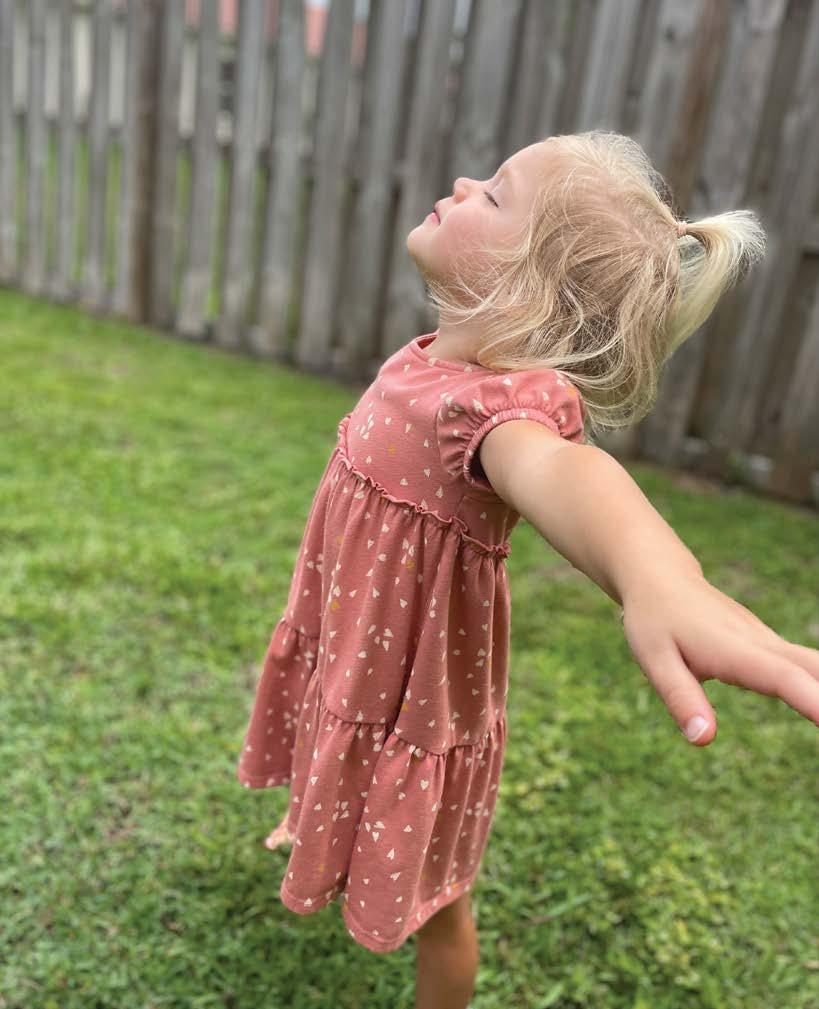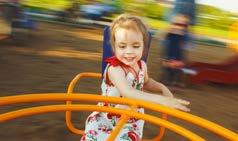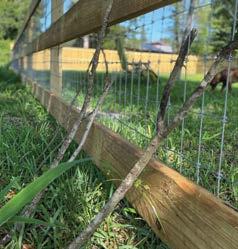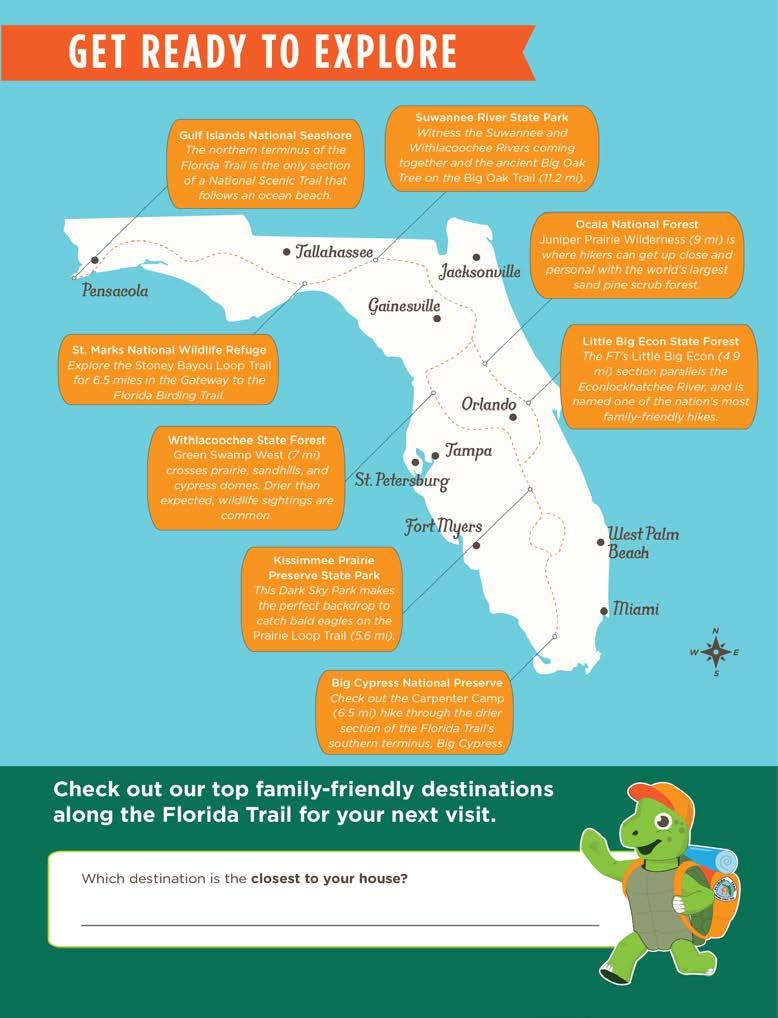
15 minute read
Nurturing Connections for Children in Nature
Nurturing Children
by Jenna Taylor, Central/South Trail Program Manager
Advertisement
Ican still see it if I close my eyes-The empty lot between my house and my neighbor’s. Out my gate, down the sandy road and into the entrance only she and I knew about. The softness of the pine needles beneath my feet as I moved toward the center of the lot. Out of sight from the road, I waited in our spot for her to arrive. We were nine years old, and this was our kingdom. Failed attempts at building a treehouse. Collections of sticks, pinecones and beauty berries. Playing for hours, just an earshot from home, but worlds away. Recently, at a Florida Trail work party, the smell of the pines was so familiar, it stopped me in my tracks. I wanted to hold onto that sensation, I wanted to be nine years old again. I wanted to discover Florida's natural world for the first time, instead of watching it vanish before my eyes. An article in People and Nature by Louise Chawla recently warned, “Within a generation, children’s lives have largely moved indoors, with the loss of free-ranging exploration of the nearby natural world, even as research indicates that direct experiences of nature in childhood contribute to care for nature across the lifespan.” What role does nature play in child development, conservation and the general wellbeing of our society? “I think I can hear the cranes getting closer.” Kennady (age 2) listens to the birds in her backyard.
“Every child should have mud pies, grasshoppers, water bugs, tadpoles, frogs, mud turtles, elderberries, wild strawberries, acorns, chestnuts, trees to climb. Brooks to wade, water lilies, woodchucks, bats, bees, butterflies, various animals to pet, hayfields, pine-cones, rocks to roll, sand, snakes, huckleberries and hornets; and any child who has been deprived of these has been deprived of the best part of education.” ~Luther Burbank- American Botanist
Cycle of connections. Chawla L. Childhood nature connection and constructive hope: A review of research on connecting with nature and coping with environmental loss.
WHY NATURE PLAY
The International Right To Play Association declared that play is “a fundamental part of life; it is a biological, social, cognitive necessity for individual children but also has benefits for society and the human species.” Benefits for the human species is a lot of pressure to put on a 5 year old’s time in the backyard. However, the global benefits of children who are allowed to play may have been overlooked as we move towards global dependency on technology and an increased focus on results. Emotional regulation is on the decline. Surveys show that one in six children have a mental health disorder including ADHD, anxiety, depression and more.

Researchers like Richard Louv attribute some of the challenges we see in our youth to something he calls, “Nature-Deficit Disorder.” In his book, Last Child In The Woods, Louv describes this disorder as: “...the human cost of alienation from nature, among them: diminished use of the senses, attention difficulties, and higher rates of physical and emotional illnesses. Nature deficit can even change human behavior in cities, which could ultimately affect their design, since long-standing studies show a relationship between the absence, or inaccessibility, of parks and open spaces with a high crime rate, depression and other urban maladies.” Louv goes on to introduce biophilia. This theory, first introduced by Pulitzer Prize winner, Edward Wilson, is the “urge to affiliate with other forms of life”. We are born with it. It is the reason so many children’s books, toys and programs are based around animals and nature. It naturally appeals to us—we don’t need encouragement to be curious. Howard Gardner, a professor of education at Harvard University, took this a bit further and described this natural affinity as an “eighth intelligence” and defined it as: “The human ability to recognize plants, animals and other parts of the natural environment.” It could quite possibly be the key to more balanced, empathetic and prepared children, yet no test exists to ensure students are being prepared in this area. Little to no time during the school day is devoted to nature exploration and children are spending more and more time utilizing technology. Without human-nature interactions, we face several dangerous feedback loops as described in an article by Masashi Soga and Kevin Gaston for The Ecological Society of America. A loss of connection with nature decreases their willingness to visit nature which may influence others (and future generations) affinity to nature. As this cycle continues, regard for environmental health declines and indifference towards positive behavior such as recycling, conservation etc. reduces and the cycle continues. The same article goes on to explain, though, that simply having access will not disrupt this cycle; a generational change must happen in children. Attention given to positive childhood experience before the age of 12 is the top factor in redirecting the loops for positive environmental attitudes and behaviors. Finally, nature play develops empathy. In a study completed by the Children and Nature Network, preschoolers exposed to nature throughout the school day showed four dimensions in children’s connection to nature: enjoyment of nature, empathy for creatures, sense of oneness and a sense of responsibility. Children exposed to nature use softer voices, gentler hands and respect living plants and animals. Though longitudinal studies are still taking place, experts anticipate that this empathy will translate into teens and adults who care about their fellow man and larger community.
FEAR
I feel it as she runs—Watching my niece sprint down the trail, words of caution leap in my throat. What if she falls? What if she comes upon a rattlesnake? What if she disappears around that curve and someone snatches her? I take a deep breath. I know this trail. She knows this trail, we visit it often. I take a deep breath. I know what I want to pass on…. and it isn’t apprehension. So what stops the potential for growth through nature? Quite simply, fear. In a particularly litigious world, opportunities to participate in perceived risky behaviors are reducing every generation. One study showed that in four generations, children went from being allowed to travel up to a mile
See Page 44 for Activity Map independently to only 300 yards. Thanks to our twenty-four hour news cycle and ever increasing access to sensational news, child abductions may seem like a huge risk, but actually account for less than one percent of missing children annually (National Center for Missing and Exploited Children, 2020). If the fear of abduction shouldn’t be what keeps kids inside, what about getting hurt? Katy Bowman, a researcher and author of Movement Matters, attributes the perceived increase in bone injuries to a combination of heavier body weight and decreased muscle strength. The CDC estimates that 19.3% or 14.4 million children are considered obese. The National Center for Biotechnology Information reported that obese children are 25% more likely to experience a bone fracture. When children are allowed to take risks, they instinctively learn how to protect themselves and prevent injury. They can test the limitations of their bodies, while connecting the neural pathways necessary to ensure the next time they try, they can recall what worked or didn’t in the past. The lessons they learn instill confidence in their bodies and allow them to feel safe to continue to try new things, which fosters creativity.

Photo courtesy of Natural England Have you ever seen a child spinning in circles for no reason? Lying on their belly on a swing? Trying to balance on a log or rolling down a hill? These actions are developing or improving one of the most important systems of the body, their vestibular system. The vestibular system is in the most basic sense, our balance sense and is controlled by the tiny hairs and fluids in our ears. This sense is what provides the body with a sense of balance, body awareness and spatial recognition. It has strong connections to cerebral development and cognition. It helps a child navigate and train their eyes on stimuli. It leads to language development and influences emotions and memory. It helps children learn how to keep their hands to themselves. It allows them to focus. By moving their bodies, they are changing their brains to better be able to react to stressors well into adulthood.

Finally, there is a fear of the unknown. Bugs, snakes, gators, dirt, germs, getting lost or struck by lightning... the list goes on and on. So often I hear things from my non-Floridian friends such as “everything in Florida wants to kill you,” or my personal favorite, “how haven’t you been eaten by an alligator by now?”. (Just to get this out of the way- according to the Florida Fish and Wildlife Conservation Commission, the risk of being the victim of an alligator bite is 1 in 13.2 million). Additionally, in our hyper sterilized world (Covid times, aside), children’s immune systems are actually becoming suppressed instead of protected. Dr. Mary Ruebush, immunologist and author of Why Dirt is Good: 5 Ways to Make Germs Your Friends, said that letting kids play in the dirt is immune-system-building step number one. Infants exposed to nature at an early age have stronger immune systems, sleep better and have a lower risk of developing allergies and asthma as they age (John Hopkins University, 2014). Through our actions and our words, we hold the answers to the next generation’s health and happiness. By allowing them to play outdoors, we let nature guide their instincts for caring for our planet.
WHAT COUNTS AS PLAY?
I can still hear it if I listen - My mom would send me out the front door with the sole

In 2008, the National Toy Hall of Fame inducted the stick. Unassuming perhaps, but unlimitless in potential. Sticks along with rocks, water, sand, string and Amazon boxes, categorized in the play community as “loose parts,” offer something that other toys cannot—potential. They can be anything a child wants them to be. Having no purpose is, in fact, their purpose. These items stimulate curiosity and imagination. instruction to “go play.” Tossed from my air conditioned luxury, I’d sit on the cool concrete driveway, staring at the fence. I would start to walk the fence line, drifting towards the pond in the backyard. With the mud squishing between my toes as I approached the edge of the murky water, I remembered the palm fronds that had fallen with the last rain. I realized if I lined them up, I could make a bridge of sorts so I set off gathering. Minutes turned to hours and as the sun set, I almost missed the call for dinner. Peter Grey, researcher on play, said that “Children need play, they need play to develop well. It is not a luxury. It is not something we should regard as recess or a break from learning. It is learning.” According to Grey, play is only truly play when it is self-controlled and self-directed. The self-direction is what gives play an educative factor. The amount of time children spend in unstructured play is reducing rapidly. Indoor and structured activities have replaced time spent outdoors coming up with something to do (this isn’t nostalgia, it is a fact). When released outside, children seem stuck and unable to come up with a game or imaginative play and often return to adults to declare boredom or to tattle. They seek constant direction and reassurance of how to spend their time.
Our twenty-first century culture is rooted in the production of results and benefits. Trophies, test scores and the ability to log and capture every moment takes even recreation and summarizes it in an accomplishment. In things like organized sports, we accept the possibility of injury because there appears to be real benefits like teamwork, dedication and perhaps even career possibilities. Playgrounds seem to have been vetted for safety and purpose. Risks like tree climbing seem like all risk and no benefits. Time spent sitting in the backyard listening to birds very rarely goes on a college application. For our smallest citizens though, unstructured play in nature can create some of the longest lasting results and benefits. Children need to be engaged in what is defined in Barefoot and Balanced as deep, meaningful play which is open-ended and exploratory in nature. This can take time for a child who is first discovering unstructured play to get into, up to 45 minutes. According to the Kaiser Family Foundation, children spend up to 7.5 hours a day engaging with a screen, 4.5 hours of which are with a television. Time spent that can actually rewire the brain. So as children move from directed play or screen time to exploring unstructured play, it will take time to rewire the impulse
WHERE DO WE BEGIN?
1) Commit to spending more time outdoors—We spend approximately 6,000 hours a year awake. Children spend 1,000 of those hours in school. What percentage of those remaining 5,000 hours could be outdoors? 1,000 Hours Outside (www.1000hoursoutside.com) has wonderful trackers, digitally and in print, to help track your goal.
2) Bring nature inside your home—Children have natural biophilic tendencies, they want to connect with nature in their homes. Allow them to grow a plant, care for a pet, press flowers and collect shells. Seek out loose part toys instead of toys with a defined use.
3) Read about it—Studies have shown that children cannot acquire new vocabulary words from a screen in the same way they do hearing them from another person or by reading them themselves. All the Discovery Channel in the world will never substitute time together reading or talking. Visit your library together and take those books outside.
4) Ask- don’t answer—In How to Raise a Wild Child, author Scott Sampson encourages adults to turn children’s questions back on them. By doing so, we give them the opportunity to solve a mystery. This encourages deductive reasoning, problem solving and puts the learner in charge. Ask them why they think that happened or what they think the animal/plant is feeling or why they did that. Be willing to say, “I don’t know but we can find out together,” and explore the topic at length.
5) Find a sitting spot—A sit spot, as defined by Scott Sampson, is a place that a child could visit on a regular basis and simply sit. It allows the child to get to know and observe one spot intimately. Perhaps this is in the backyard or perhaps your favorite trail. As the child grows, consider a photo or paper journal of observations. Track what they see and hear. According to Sampson, “the best spot is one you use,” so select convenience over grandeur and just be still in the space together.
6) Avoid saying “be careful”—Saying “be careful” implies there is danger ahead. Encourage problem solving and planning through dialogue so they have self efficacy in how they proceed. Taking risks means failing. But failing means you tried instead of being fearful of making a mistake.
Do you feel safe there? I noticed ? What do you think will happen if you ? Is it slippery ? How will you get down from there ? Sticks need space. Where can you and swing that? Are you balanced? If you do that will anything/anyone get hurt? Move slowly. How will that feel on your ? Should we try that together?

WHAT IF I DON’T HAVE A CHILD IN MY LIFE?
Florida is changing. There is no hiding that. Currently the third most populous state, our green spaces and water sources continue to shrink. Florida continues to need advocates for green spaces for future generations to enjoy. 1) Join the fight—Consider joining our partners at the Florida Wildlife Corridor to learn more about their efforts to permanently protect and connect the corridor. 2) Recommend the Florida Trail to neighbors and friends—Don’t keep your favorite section a secret. We need to create the next generation of trail lovers. The age of influence is 12, after that it becomes harder and harder to create long lasting connections to a space. 3) Be a welcoming ally to families and children—Not all families recreate the same way you think is best. They might be loud. They may run. They might squeal from excitement when they see a deer and scare off wildlife. Let them. Model for them. Show them grace. Help them be explorers.

There is a proverb that says, “It is better to know one mountain than to climb many.” No one needs to travel far to experience nature. Work with what you have and grow when you can. Allow yourself to sit and to be uncomfortable while the child in your life learns to play in nature. Provide guidance but not answers. Allow nature to nurture the empathy and imagination inside every child. Four generations. That is all it took to change how children experienced nature. What happens in the next four is up to us.
FOR MORE READING
For grown ups
"Balanced and Barefoot" —Angela Hanscom "How to Raise a Wild Child" —Scott Sampson "Last Child In the Woods"—Richard Louv "Wild Play- Parenting Adventures in the Great Outdoors"—David Sobel "There’s No Such Thing As Bad Weather" —Linda Akeson McGurk
To read together
"How to Be a Good Creature" —Sy Montgomery "We Are Water Protectors" —Carole Lindstrom "The Wonders of Nature" —Ben Hoare "Hiking Day"—Anne Rockwell "The Hike"—Alison Farrel "Hike"—Pete Oswald

Photo courtesy of Jenna Taylor







